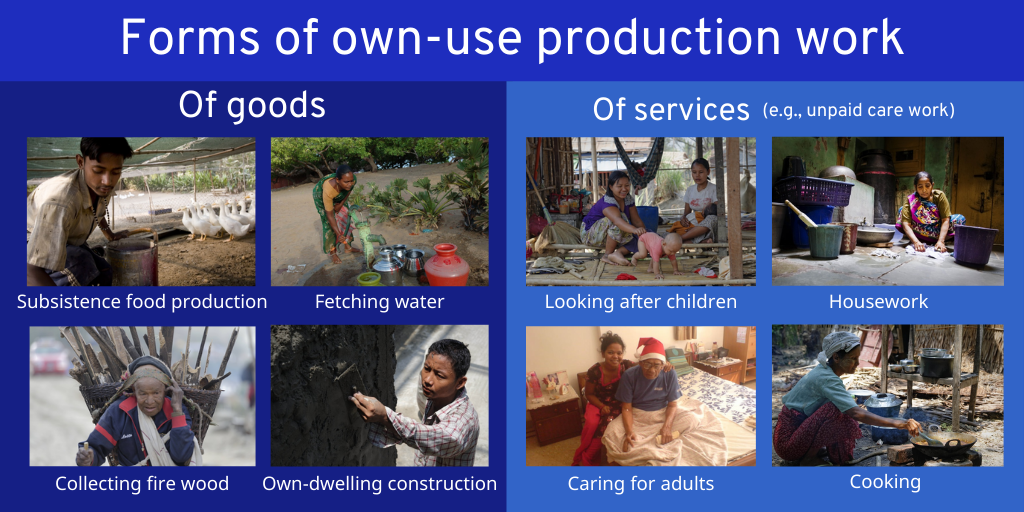From subsistence food production to looking after children and the elderly, 187 million hours are spent on unpaid production work every day in five countries in the Asia-Pacific,1This blog presents data from Lao PDR, Nepal, Mongolia, Cook Islands, and Tonga. 60 per cent of which are worked by women. With the vast majority of working-age persons engaged in unpaid production work — 24 out of 28 million in the five countries analysed — the scale and weight of collective hours spent warrant greater efforts to incorporate unpaid production work into any standard assessment of labour, productivity and economic growth outcomes. Increasingly, survey instruments do allow us to measure the scope and scale of unpaid production work and thus could be used to make such invisible work visible.
The 19th International Conference of Labour Statisticians (ICLS) resolution introduced the technical term own-use production work to define all inputs of labour involved in the production of goods and services for own final use. This concept captures the type of work that commonly accepted as unpaid production work, within which the provision of services is also known as unpaid care work. Unpaid production workers are defined as individuals of working age who conducted at least one hour of work in producing goods or providing services for own final use. The figure that follows shows the various forms of unpaid production work in greater detail.

While labour force participation among women in the Asia-Pacific is slightly higher than other regions, inactivity rates remain high in comparison to men. What’s more, young females are far more likely to be neither in employment nor in education (NEET) compared to young men, especially in South Asia. The counterpart is that more women engage in unpaid work than men. In all five countries with available data in Asia and the Pacific, the share of women who engaged in unpaid work is higher than men. In addition, more than two-thirds of working-age women (10 million) in these countries were doing unpaid work as their sole activity, while this ratio for men was only 41 per cent (or 5 million).
Gender norms result in women spending disproportionally more time than men in these activities. In Nepal and Mongolia, two-thirds of all unpaid production work was done by women. The unequal distribution of the workload is particularly noticeable among the subcategory unpaid care work. On average, women performed 80 per cent of unpaid care work in these five countries. In Nepal, women carried out 85 per cent of daily unpaid care work, spending a total of 29 million hours a day (cumulatively) compared to 5 million hours spent by men.
What are the consequences of the unbalanced distribution of work?
For many youth (persons aged 15–24), time spent on household work means time spent away from education. In Nepal, 94 per cent of young women NEETs were involved in care work in households. This is two times higher than the share among male NEETs. During times of crisis, young girls are often the first pulled out of school, so it is likely that one impact of the current COVID-19 crisis in Nepal and elsewhere will be an increase in the share of young women NEETs and young women in unpaid production work. It is not just young women who are taking on an increased unpaid workload during the current crisis period. With children out of school, care needs of elderly and other family members are heightened, and women have found themselves having to juggle their own work with added household responsibilities. Under this strain, some women have given up paid work in order to carry out the additional family duties, which is likely to exacerbate gender inequality.
More time spent in unpaid household work also means fewer opportunities for paid employment. This problem comes from two sides. From the supply side, with less time available for paid work, there are fewer women looking for jobs, causing higher rates of female inactivity. In Nepal, more than one million working-age women (9 per cent) were willing to work in a paid job but they were not looking or unavailable for jobs because of family responsibilities or family members considered they should stay at home. On the demand side, gender-based discrimination remains common in countries within this region, with enterprises reluctant to hire women, especially women of child-bearing age. Without paid work, women face higher financial insecurity, especially at older ages.
What's next?
We have a long way to go to reduce the unequal allocation of unpaid household care work between men and women. It starts by changing stereotypes. Care work is everyone’s responsibility, not just women’s work. And we all have a part to play to make this change. First, all of us – men and women – should do our fair share of work at home; we can take it upon ourselves to redistribute the workload. Second, governments should implement policies that support care work, such as investing in public care services for children, the elderly, and persons with disabilities and guaranteeing paid family leave from work and paid sick leave, as means to reduce the household burden. Last but not least, national statistical offices should implement the first resolution from the 19th ICLS to increase the number of labour force surveys that measure unpaid production work. Less than half of the countries in Asia and the Pacific region have implemented it so far, and this is far better than other regions.
This post was drafted by Yamei Du, Intern at the ILO Regional Office for Asia and the Pacific.
Author
-

ILO Regional Office for Asia and the Pacific
This ILO regional office covers 36 countries and is one of the most diverse in the world – ethnically, culturally, religiously and economically. Learn more »
View all posts
